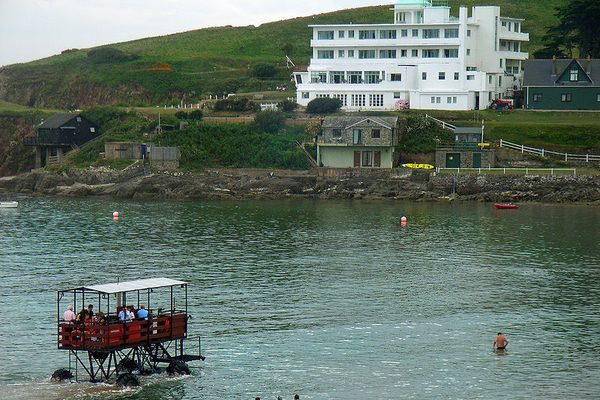The Unique ‘Sea Tractor’ That Carries Passengers Over the Waves
When the tide comes in, this unusual vehicle brings visitors to Burgh Island in England.

England’s Burgh Island has always been shrouded in a mystique. After Archibald Nettleford bought the island in 1927 and opened up a hotel, the papers made sure to note that the spot was once a favorite of pirates and smugglers. Nettleford himself was an enigmatic figure, a blind man who owned a movie studio. But the most newsworthy feature of the hotel was the vehicle used to transport visitors to island—the “sea tractor,” a one-of-kind marine vehicle.
This invention, as the Baltimore Sun reported in 1931, was supposed to be “the only conveyance of its kind in the world.” It involved “a street car set upon caterpillar tractors,” which looked like a platform on stilts, half-tank, half-cable car. At low tide, it was possible to walk to the island; at high tide, the tractor would ferry guests across the water “while the waves splash and break around the top deck,” according to the Sun.
The sea tractor did not take the world by storm. Edging on 90 years later, there are still only a few in the world. But at Burgh Island, it’s still a key mode of transportation.
“When the tide is in, then we go across with our sea tractor,” says Vladimir Krupa, the hotel’s general manager.

The first sea tractor had a set of a wheels and a set of tracks; according to Krupa, the designers worried that, with more wheels, the tractor would sink too deeply into the sand. While the platform moves high above the waterline, the wheels and tracks moved across the sea bottom. But over time, the salt water corroded the machine. The second one was built in 1949 and lasted 20 years, until its metal parts rusted out.
At that point, in 1969, the hotel considered other options. They wanted something that would last. Should they have a hovercraft? A simple boat?
In the end, they redesigned the sea tractor. It now only uses wheels to move—there are no treads involved. “It looked similar, but they rebuilt it completely,” says Krupa.

Since then, the sea tractor has been fine-tuned but the principle has remained the same. Specially trained drivers pilot it across the water. It’s not a long ride—less than 275 yards—and it takes about five minutes.The machine doesn’t have any gears and goes about five miles per hour, max. The hotel will take visitors back and forth more or less on demand but makes sure they initially arrive at low tide. If the weather’s bad, the sea tractor doesn’t run: Watching it trying to make the crossing when the waves are high is harrowing.
There are a handful of other places in the world, including the nearby South Sands Beach, that have sea tractors, as well. But Burgh Island’s is the best known. At this point, the hotel keeps it running in part because it’s been running for so many years. “We pride ourselves on time traveling,” says Krupa. Guests wear black tie to dinner; the sea tractor keeps trundling across the water to Bigbury-on-Sea when the tide is high. Tides are so regular, Krupa says, that they could use tide charts to look a hundred years in advance to know when guests should arrive; if the hotel is still around in another century, perhaps the sea tractor will be, too.
Later this year Atlas Obscura will be leading a trip that includes a stay on Burgh Island. For announcements about new adventures and other exciting updates, sign up for the Atlas Obscura Trips newsletter!
















Follow us on Twitter to get the latest on the world's hidden wonders.
Like us on Facebook to get the latest on the world's hidden wonders.
Follow us on Twitter Like us on Facebook